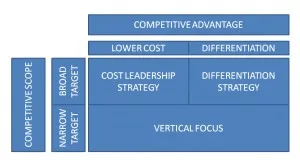This week we have three event reports across the two publications. Mobile Display Monitor includes a substantial report on the Mobile World Congress in Barcelona last week, while the Large Display Monitor has reports on the European Congress on Radiology and the Passenger Terminal Expo. While the MWC event is a very “horizontal” event, because of the widespread adoption of mobile technology, the others are very vertical. At MWC I attended the Samsung Unpacked event where the Galaxy S6 was launched, and I watched the Apple launch this week online – a very good comparison between the two most successful consumer electronics companies. All of this got me thinking about business and marketing strategy.
My guru on strategy was always Michael Porter and he said that there are only three generic strategies. The first is cost leadership – being the cheapest (often by being the biggest) is usually a sustainable strategy if you can be sure that you have really good reasons for that leadership, such as access to raw materials at prices lower than rivals. Because technology-based businesses need so much R&D and design work, this strategy is hard to sustain in the kinds of market we look at, although scale can be an enabler. If you have enough volume, you may get some edge, but, as the TV makers have found, there isn’t a huge cost advantage to scale.
The second strategy is differentiation – that is to say making better, distinctive or higher performing products than the competition. That’s clearly the strategy of both Samsung (in its mobile and electronics business, at least) and Apple. Apple clearly won the battle for me over the last couple of weeks. Personally, I’ll probably upgrade to a Samsung S6 when I next change my phone, but only because I have tended to resist the “closed” world of Apple. However, from the point of view of the marketing, Apple made me think much longer and harder about the kind of features and specifications that it has developed.
Apple understands that if it is to claim an advantage, it’s much better if it “shows its working”. Samsung showed how its cameras were better than Apple, but Apple spent a lot of time explaining how its engineers had designed special batteries and materials to improve its products. I have no doubt that Samsung’s engineers put as much time in, but Apple’s marketing was much better.
Anyway, the second strategy that we tend to see in vertical shows such as ECR and PTE is Porter’s vertical focus. Companies such as Barco, Conrac, Eizo and NEC that we saw at these shows, all have clear vertical strategy. They develop very specific products that address the particular needs of narrow target audiences – at PTE we saw products for those responsible for displays in airports and other transport areas, or, in the case of ECR, for those that care about medical imaging.
Here, I was very impressed not only with the very clear vertical focus strategy shown by Barco at ECR, but also by the way that it made sure its message was coming across. Even in small vertical markets, good marketing makes a difference. Barco really seemed to have got close to users of its medical displays to understand their day to day frustrations and workflows to design product features that very specifically addressed those issues. It has gone beyond “meeting the standards” and “having a better product” to “making my day easier”. At least, that’s what its marketing staff said!
Apple is an interesting case study in how to move from one kind of strategy to another. When the Mac was struggling, Apple, effectively had just one or two vertical markets. It was the very clear leader in pre-press and publishing and was also strong in education. Without these vertical markets, which it served with software such as Pagemaker and Photoshop as well as postscript printers and links to typesetting machines, it would not have survived to become the behemoth that it is now.
Some of the graphics that are on the web showing Porter’s model have a region in the middle which is the “death zone”, where you’re not really the cheapest or the best or focussed. It’s amazing how many companies I have spoken to over the years that seem to be somewhere in there!
Bob

